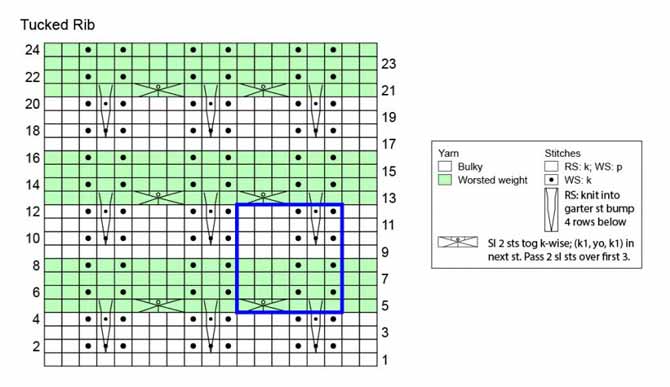My curious mind doesn’t stop, especially when it comes to knitting and designing. Because I had 2 Deluxe Superwash yarns that were the same color, I thought I’d experiment to see how I could use these 2 yarns together in the same swatch. Knitting into the row below, or in this case rows below, produced some interesting results.

Close-up of Tucked Ribbing
The bulky yarn rows were basically a 3×3 ribbing, but I used garter stitch in between the columns of stockinette stitch instead of the usual reverse stockinette stitch. Then, I let the worsted weight yarn “do all the work” making the stitch pattern look interesting.

Full-on view of tucked rib swatch with knit below rows
The first maneuver I did with the worsted weight yarn was to work a double decrease/double increase in the same stitch. To do this, I slipped 2 stitches together, as if I were going to knit them together. Then in the 3rd stitch I knit 1, made a yarn over, knit 1, all in the same stitch. Then I took the 2 slipped stitches — now the 4th and 5th stitches on the right-hand needle — passed them over the first 3 stitches, and voila!
The second technique, the one where I knit into rows below, happened in the center stitch of each garter stitch section. I inserted the needle just below the garter stitch bump, not just 1 row below, but 4 rows below. This is the 2nd garter stitch bump of the center stitch. Then I knit through as usual, trapping all the strands of yarn that had been knit into that center stitch in the rows above. This brings up a lovely “V” shaped knit stitch and after a bit of massaging, there are strands that drape outwards to the left and right from behind the V. I really like this look.
If I were to try this again, I’d use the Deluxe DK superwash weight instead of the worsted weight for an even greater contrast and a lacier look. Hmmm, I wonder what it would look like in 2 different colors.
Here’s the stitch chart for you to try this yourself. Please share pictures of what your project or swatch looks like.

Tucked Rib Stitch Chart
This is part 5 of 5 in this series.
Go back to part 4: Knitting with Deluxe Superwash

4 comments
Never tried this technique but I want to
Please come by and let us know how it goes when you’ve given it a try.
I have a hard time visually seeing the stitches once I get going, after about 6 stitches into the diff row….I cannot tell the difference between the original row and the row I am supposed to be working into, they seem to get to jumpy looking I can’t tell them apart. Any tips for that. I use a light and stitchmarkers…but i get so confused.
Hi Karen. Markers and light will help a little, so that’s a good start. To find the “row below” I do the following as I “read” the stitches on me needle. I tug the fabric down a little. The strand that makes the loop or the next stitch on the needle is the stitch I’m working into, so I guess some may call this the row below, because it’s the row that is “below” the one you are currently working into, so the terminology doesn’t help much, but it’s what’s used, so we’re a little stuck with that. At any rate, tug on the fabric below the next stitch. You’ll see that from the stitch that’s on the left-hand needle, two legs come down into (or protrude from) the same loop (or stitch). If you insert the right-hand needle between the 2 legs and into the loop from which they come out and then knit, you’ll have “knit into the row below” correctly. Let me know if this helps.